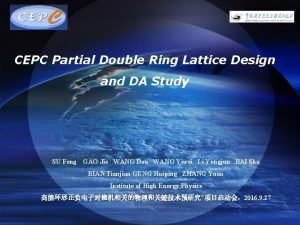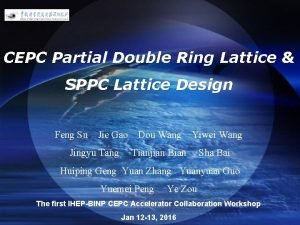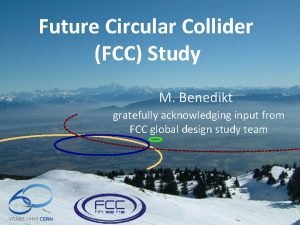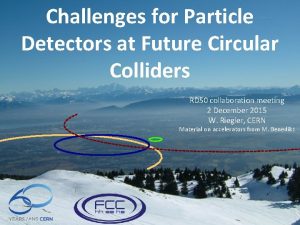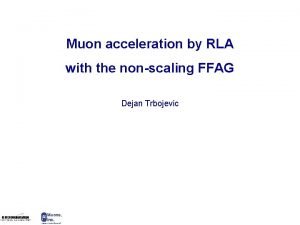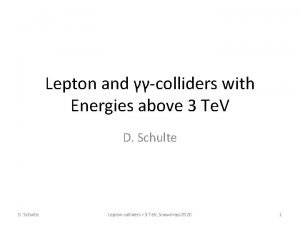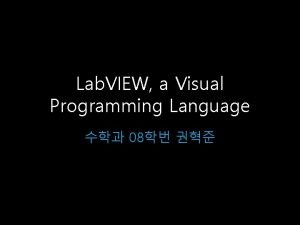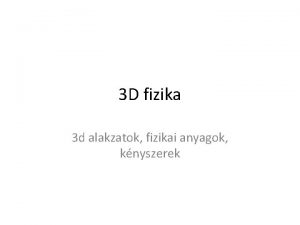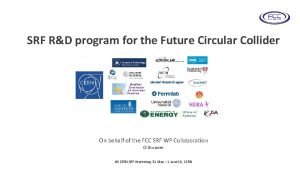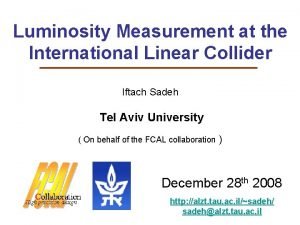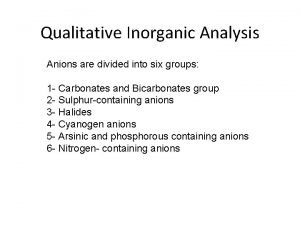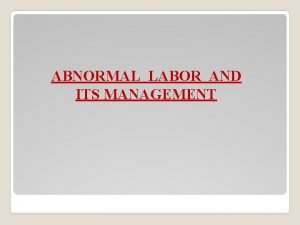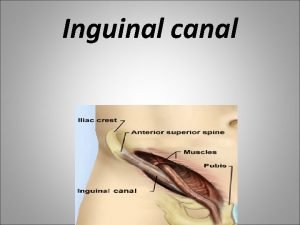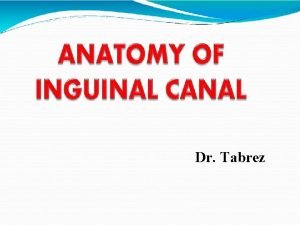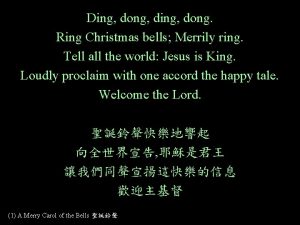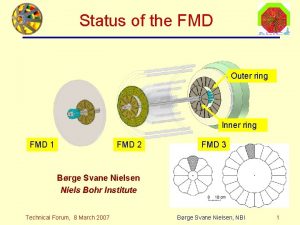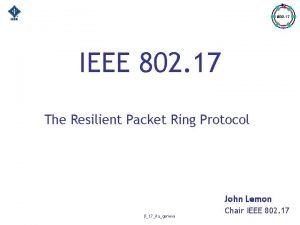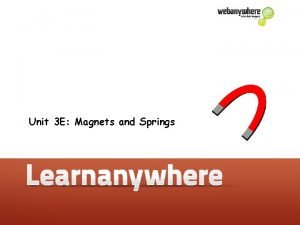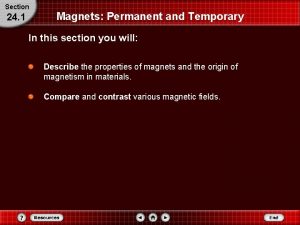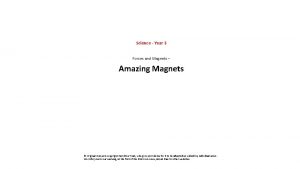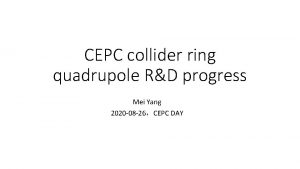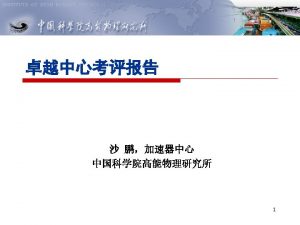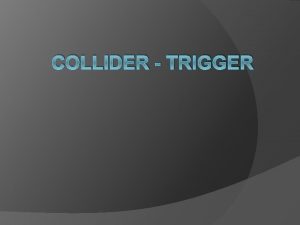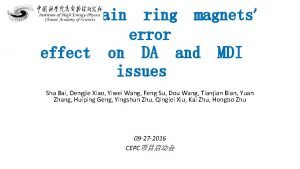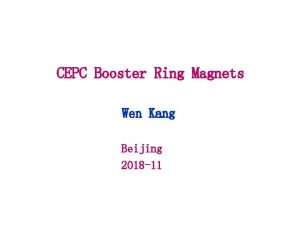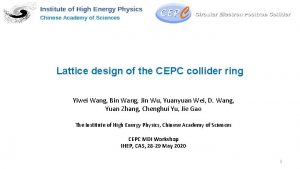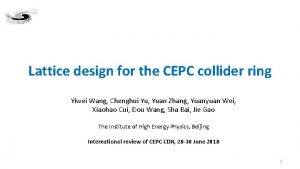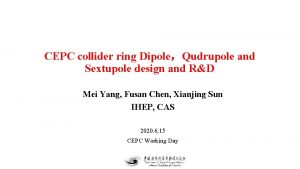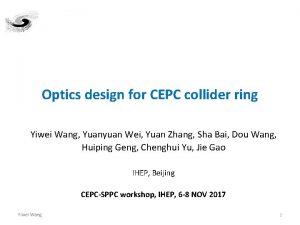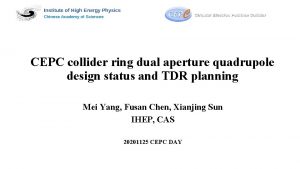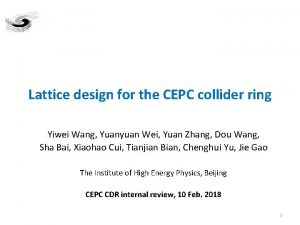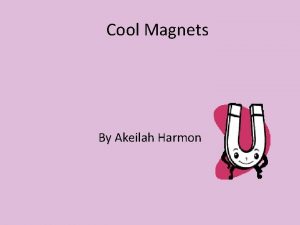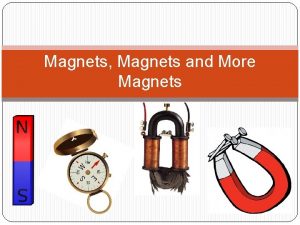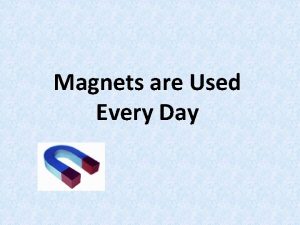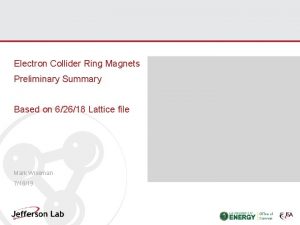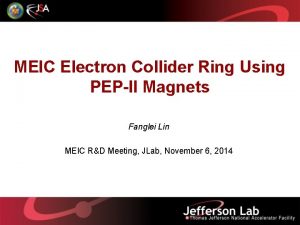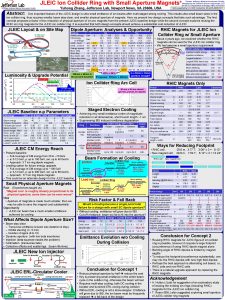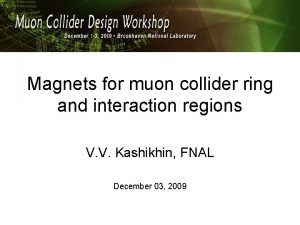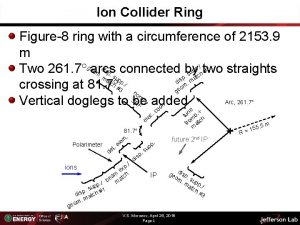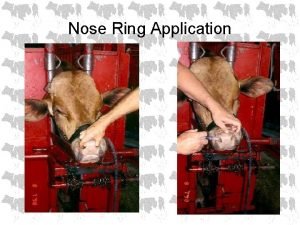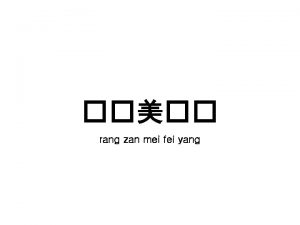Development of CEPC Collider Ring Magnets Mei Yang














![Physical design of DAQ prototype • Design parameters of DAQ prototype Gradient [T/m] Aperture Physical design of DAQ prototype • Design parameters of DAQ prototype Gradient [T/m] Aperture](https://slidetodoc.com/presentation_image_h2/7250349ac1c634045c37baa96c9154fe/image-15.jpg)









- Slides: 24

Development of CEPC Collider Ring Magnets Mei Yang, Fusan Chen, Xianjing Sun IHEP, CAS 20191230 CEPC Working Day

Outline • Introduction • Dual aperture dipole(DAD) • Physical and mechanical design • Earth field effect simulation • Primary measurement results of prototype • Dual aperture quadrupole(DAQ) • Physical and mechanical design • Prototype progress • Primary measurement results of prototype • Sextupole magnet design • Summary

Overview of collider magnets • Over 80% of collider ring is covered by conventional magnets. All these magnets work at DC mode. Dipole Quad. Sext. Corrector 2384 2392 - - 80*2+2 480*2+172 932*2 2904*2 Total length [km] 71. 5 5. 9 1. 0 2. 5 80. 8 Power [MW] 7. 0 20. 2 4. 6 2. 2 34 Dual aperture Single aperture • The most important issues are Cost & Power Consumption. • • • Make the magnets compact and simple. Aluminum wire is used for the excitation coils. Dual aperture magnets save nearly 50% power consumption. Consider the combined function magnets. Increase the coil cross section and decrease the operating current. Total 13742

Parameters of the DAD • Parameters of main dipole magnets. Field strength(Gs) Aperture(mm) Effective length(m) GFR(mm) Adjustment capability Field quality 140 Gs~373 Gs 70 28. 7 m, 5 parts 13. 5 ± 1. 5% 5× 10 -4 • Short prototype of DAD (1 m in length) • • • Central field: 140 Gs@45 Ge. V~373 Gs @120 Ge. V Difference between the two aperture center fields <0. 5% High order harmonics<5× 10 -4 @R=13. 5 mm(except b 3) Separate coils in two apertures:± 1. 5% Size of vacuum chamber:(W*H) 99 mm × 62 mm Thickness of radiation lead: 25 mm 4

Physical design of DAD prototype • 2 D&3 D OPERA simulations are done and the results meet the requirements. Ap 2 -t Ap 1 -a 66. 6 mm 78 mm 71. 8 mm 350 mm Ap 1: Field adjustment@120 Ge. V Field strength at different energy E(Ge. V) J(A/mm 2) 45 0. 263 Ap 1 B 1(T) Ap 2 B 1(T) Ap 1 S(T/m 2) AP 2 S(T/m 2) 0. 01409 0. 01405 1. 846 -2. 640 80 0. 463 0. 02486 0. 02484 3. 257 -4. 668 120 0. 694 0. 03732 0. 03734 4. 888 -7. 017 B(T) S(T/m 2) B B+1. 5% B-1. 5% 0. 037324 0. 037892 0. 036756 4. 888 4. 9612 4. 8145 Harmonics(Bn/B 1, 1 e-4) 1 10000 2 -0. 68 -0. 606 -0. 751 3 119. 34 119. 309 119. 362 4 0. 795 0. 778 5 -3. 423 5 -3. 418

Physical design of DAD prototype • Integral field and higher harmonics at 120 Ge. V Integral field @120 Ge. V High harmonics@120 Ge. V Ap 1 Ap 2 BL(T. mm) 41. 605 41. 457 B 0(T) 0. 03732 SL(T/m) Leff(mm) Ap 1: Field adjustment @ 120 Ge. V Ap 1 B B+1. 5% B-1. 5% BL(T. mm) 41. 605 42. 229 40. 981 Ap 2 1 10000 0. 03733 2 2. 72 1. 06 1 10000 5. 168 -7. 036 3 113. 60 -155. 236 2 -2. 72 -2. 51 -1. 83 1114. 7 1110. 7 4 2. 83 -1. 92 3 113. 60 113. 85 5 -3. 11 2. 0 4 2. 28 2. 35 2. 38 Harmonics(Bn/B 1, 1 e-4) 5 -3. 11 -3. 09 -3. 08 Conclusion Ø The magnetic field coupling between the two apertures can be ignored in the case of existing correction coils. Ø The magnetic field has a linear relationship with the current, without considering the hysteresis effect.

Mechanical design of DAD prototype • • Liron=1 m, solid yoke , three parts; Main coils: aluminum bus bars, 4 turns, air cooled, interconnect by screw; Trim coils: copper wire, 4 turns per pole, air cooled; Two stainless steel supporters to increase rigidity of the overall structure. CAD model of dual aperture dipole Dual aperture dipole prototype Magnetic strength [T] Aperture [mm] Turns Material Main coil Current [A] Current density [A/mm 2] Power consumption [k. W] Turns Material Trim coil Current [A] Current density [A/mm 2] Power consumption [k. W] Tot cross section(mm) Iron length (mm) Iron weight(kg) Al weight(kg) Cu weight(kg) 0. 0373 70 4 Aluminum 563 0. 7 0. 12 1× 4 Copper 16. 7 0. 093 0. 0005 535*200 1000 510 22 0. 3

Earth field effect simulation on DAD • The earth field is ~0. 5 Gs, which is 0. 36% of the lowest field 140 Gs at 45 Ge. V. • A pair of current plates are used to approximate the earth field effect on the field distribution of the DAD. • Case 1: only the earth field E 0. 5 Gs------~0. 5 Gs • Case 2: E 0. 5 Gs+B 0 Gs with Iron-------0. 012 and 0. 032 Gs in two apertures. • The magnetic flux is bent and concentrated through the iron core for its magnetic resistance is much smaller than that in the air. • The field uniformity at the GFR is less than 5%. • Case 3: E 0 Gs+B 140 Gs and Case 4: E 0. 5 Gs+B 140 Gs • The central field difference is less than 2. 5 e-4 of 140 Gs.

Magnetic measurements: dipole transfer function • The transfer function at two apertures: • Center field difference <0. 3% in two apertures(residual field effect and different gaps at the two apertures). Ap 2 Ap 1 Dipole measured by a hall probe system B/I Transfer function By along z at different energy

Magnetic measurements: field difference and harmonics • Integral field differences • Difference is less than 0. 15%@45 Ge. V. • Harmonics@Rref=13. 5 mm E(Ge. V) Ap 1 Ap 2 By. L(T. mm) Differ 45 15. 3972 15. 3765 -0. 13% 80 27. 3358 27. 3199 -0. 06% 120 41. 2001 41. 1810 -0. 05% Harmonics at two apertures Measured integral field in the vertical midplane (y=0) n Ap 1@45 Ge. V Ap 2@45 Ge. V 2 5. 38 -1. 40 3 113. 24 -157. 23 4 4. 49 -2. 00 5 0. 015 2. 14 6 -5. 29 2. 60

Temperature rise • For the aluminum busbar is aluminium alloy, the resistance is high than pure aluminum and there is a large contact resistance. The local temperature is up to 60 degrees@120 Ge. V @562 A. (at the end of the coil) • The water cooled aluminum busbars will be used in long dipole magnet.

Long DAD design • As the magnetic length is up to 28. 7 m, the 5. 7 m model will be built to check the field quality, mechanical strength and deformation. • Using the same cross section of 1 m long model, without end chamfering, the 5. 7 m model can meet the field uniformity requirement. All the other harmonics are less than 5 units. BL(T. mm ) Ap 1 Ap 2 217. 1834 217. 0064 Harmonics(Bn/B 1× 10000) 1 10000 2 2. 87 -1. 34 3 116. 55 -169. 29 4 -0. 97 0. 79 5 --3. 31 2. 76

Dual aperture quadrupole(DAQ) (by F. S. Chen) • Requirements of DAQ(number: 2392) Gradient(T/m) Aperture(mm) Effective length(m) GFR(mm) Adjustment capability Field quality 8. 42 76 1 or 2 12. 2 ± 1. 5% 5× 10 -4 • Prototype study • • Complex structure to verify assembly tolerances and mechanical structure Cross talk effect and compensation method study Verify the hollow aluminum wires Effect of trim coils on the main field

Physical design of DAQ prototype • 2 D simulation results Bn/B 2 Without shielding 1 -2132. 7 Shielding sheet (t=11. 52 mm) -0. 2 3 -169. 9 0. 0 4 0. 5 5 -2. 3 0. 0 6 -0. 1 0. 0 7 0. 2 0. 0 Mechanical decoupling • 3 D simulation results • The iron plate can not compensate b 1 & b 3 at once. Shielding thickness 11. 2 mm 13 mm 16 mm 19 mm B 1/B 2 -667 -413 38 371 B 3/B 2 -82 -63 -30 -4 Magnetic compensation
![Physical design of DAQ prototype Design parameters of DAQ prototype Gradient Tm Aperture Physical design of DAQ prototype • Design parameters of DAQ prototype Gradient [T/m] Aperture](https://slidetodoc.com/presentation_image_h2/7250349ac1c634045c37baa96c9154fe/image-15.jpg)
Physical design of DAQ prototype • Design parameters of DAQ prototype Gradient [T/m] Aperture [mm] Turns Material Main Current [A] coil Current density [A/mm 2] Power consumption [k. W] Turns Material Trim Current [A] coil Current density [A/mm 2] Power consumption [k. W] Velocity [m/s] Cooling Flux [l/s] water Temperature rise [°C] 8. 42 76 64× 2 Aluminum 154 1. 89 3. 3 20× 4 Copper 7. 2 0. 9 0. 04 1. 3 0. 201 6. 3 15

Mechanical design of DAQ prototype Short model (1 m in length), laminated yoke • Trim coils : ± 1. 5% adjustability, enameled copper wire • Main coils: hollow aluminum coils, water cooled, 64 turns/pole • Large size of wire and low current density • Stainless steel as a supporter and separate two yokes.

Dual aperture quadrupole prototype • The DAQ prototype has been finished and will be measured later. Hollow aluminum wire Iron of dual aperture quadrupole Main coil Dual aperture quadrupole prototype

Primary measurement results • Hall Probe measurement with the DT 4 sheet. • Aperture A: Defocus G<0 • Aperture B: Focus G>0 • GL is obtained by the integral field at x=-12. 2 mm and 12. 2 mm. A B

Primary measurement results-2 • Magnetic axis location • The magnetic center in horizontal direction is shown below. The Xcen shift by 2 mm in aperture A and by -1. 7 mm in aperture B when the energy rises from 45 Ge. V to 182. 5 Ge. V. The magnetic center distance between the two apertures is less than 350 mm and shifted by 3. 7 mm in the ramping process. Aperture A G<0 350 mm Aperture B G>0

Primary measurement results-3 • The gradient difference between the two apertures is about 0. 5%. E(Ge. V) I(A) GL(T)-A GL(T)-B GL_A/GL_B-1 45 57. 99 -3. 36 3. 35 0. 40% 80 101. 99 -5. 91 5. 88 0. 59% 120 153. 98 -8. 89 8. 85 0. 49% 148 189. 98 -10. 93 10. 89 0. 40% 175 223. 99 -12. 77 12. 73 0. 30% 182. 5 233. 99 -13. 27 13. 21 0. 40%

Primary measurement results-4 • More measurement results will be done without and with different depths of the compensation dt 4 sheet. • The harmonics will be obtained by rotating coil measurements results or SSW measurements.

Sextupole magnet design • Two single aperture sextupoles are installed side by side. • • Core size is limited by the 350 mm beam center separation. Use copper for coils & enlarge the cross section as much as possible. 10 mm gap between two magnets but the cross talk effect can be ignored. Field Strength: 191 T/m 2 @45 Ge. V to 506 T/m 2 @120 Ge. V • Optimization • Rearrangement of the wire layout and enlarge the yoke from 28 mm to 37 mm. (by X. J. Sun) 22

Summary • The design of combined dipole and sextupole magnet with aluminum bus bars is accessible. The center dipole field and sextupole strength is basically consistent with the design value. • Further field measurement will be taken by the stretched wire or rotating coil measurement system. • The water cooled aluminum conductor will be considered for long dipole model magnet. • A long segment of dipole magnet is in schedule. • The DAQ prototype will be also measured by the stretched wire or rotating coil measurement system. The cross talk effect of the DAQ will be further studied and discussed with physics. • A sextupole magnet prototype is in plan.

Thanks for your attention!
 Cepc logo
Cepc logo Cepc logo
Cepc logo Fcc collider
Fcc collider Fcc collider
Fcc collider Muon collider
Muon collider Muon collider
Muon collider Particle collider
Particle collider Unity sphere collider
Unity sphere collider Hadron collider
Hadron collider Hadron collider
Hadron collider Fcc-ee
Fcc-ee International linear collider
International linear collider Analysis of anions
Analysis of anions Ring uterus
Ring uterus Inguinal area
Inguinal area Superficial inguinal ligament
Superficial inguinal ligament Ding dong ding dong christmas bells are ringing
Ding dong ding dong christmas bells are ringing Ring christmas bells ring them loud
Ring christmas bells ring them loud Inner ring and outer ring
Inner ring and outer ring Token ring and resilient packet ring
Token ring and resilient packet ring Organisasi profesi humas yang berada di indonesia adalah
Organisasi profesi humas yang berada di indonesia adalah Magnets for year 3
Magnets for year 3 Magnets and springs
Magnets and springs Difference between permanent magnet and temporary magnet
Difference between permanent magnet and temporary magnet Attract repel
Attract repel
